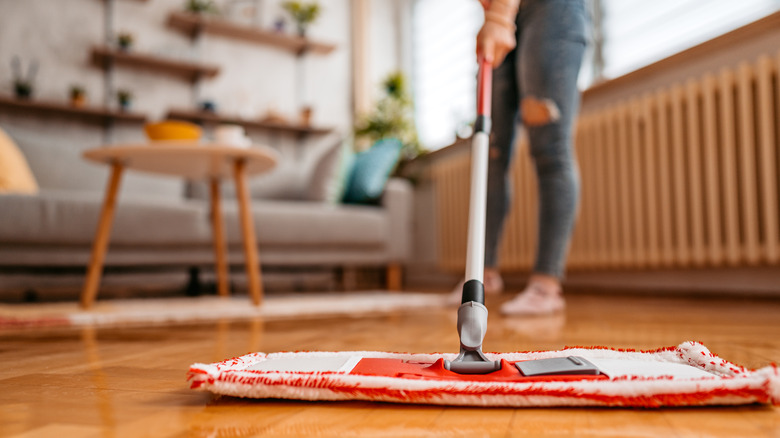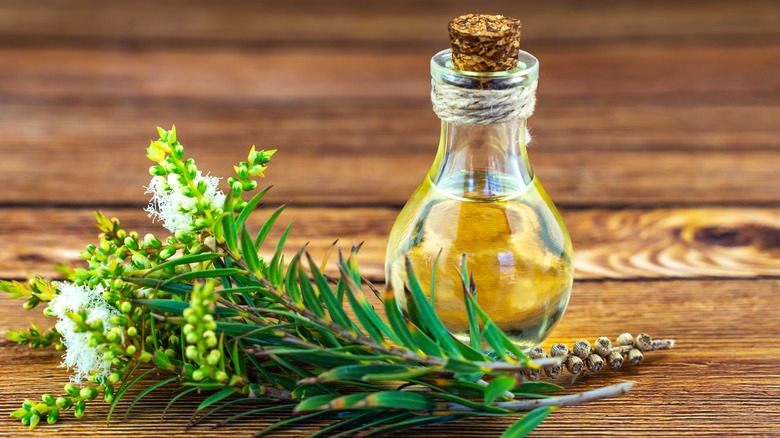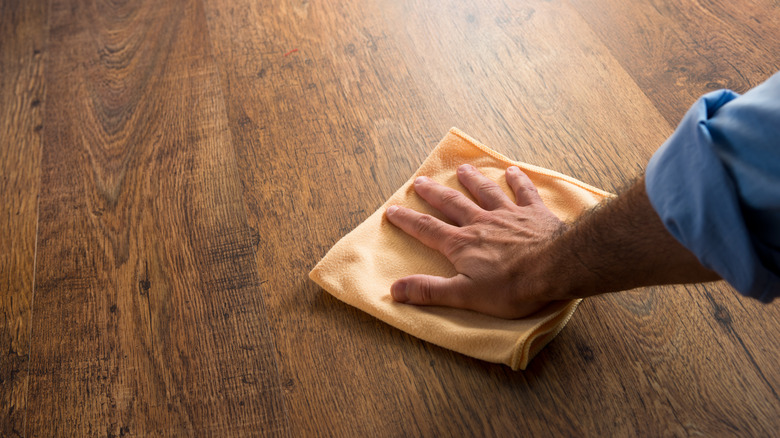The Secret Ingredient You Should Be Using To Clean Your Hardwood Floors
To maintain the natural beauty and longevity of your hardwood floors, the cleaning products you choose are crucial. Surprisingly, an effective solution lies in a common essential oil: tea tree. Creating a cleaning solution with this oil is straightforward. Just mix a few drops of tea tree oil with warm water or vinegar and use to your heart's content. You can mix the solution in a bucket for mopping, or spray it for smaller-scale cleaning. The natural antibacterial qualities of tea tree oil make this mixture an excellent option for maintaining your hardwood floors in a more natural and environmentally friendly way.
Although there isn't much scientific research on tea tree oil's long-term effects on wood floors, there is a lot of anecdotal evidence from wood care experts that the oil is effective for cleaning. A 2006 study published in the journal Clinical Microbiology Reviews emphasizes the role of a compound called terpinen-4-ol in tea tree oil, which is particularly effective at inhibiting bacterial growth. Besides terpinen-4-ol, tea tree oil contains other compounds like cineole and pinene, which also contribute to its overall antimicrobial efficacy. These compounds work together to provide a broad-spectrum antimicrobial effect, making tea tree oil a valuable and proven addition to your floor-cleaning regimen.
Using tea tree oil to clean hardwood floors
When using the tea tree oil mixture on your floors, it's crucial to remember that, while tea tree oil is great for disinfecting and cleaning hardwood floors, the way you apply it is just as important. Another key thing to watch out for is the concentration of the oil in the cleaning solution. This is because essential oils, including tea tree oil, often contain alcohol. When used in high concentrations, alcohol can be detrimental to wood floors. It can cause discoloration and damage the finish. In other words, alcohol can eat away at the protective coating, leaving the wood vulnerable to damage. However, keep in mind that different finishes may have varying reactions to substances. For instance, floors with a polyurethane coating might be more resistant to water and oil-based solutions than those with a lacquered or varnished finish.
To ensure safety and avoid any adverse reactions, conduct a patch test on a small, less visible area of your floor before proceeding with a full cleaning. This precaution helps you ascertain how the finish on your floors will react to the tea tree oil solution. Also, always make sure to dilute tea tree oil adequately with water. A general rule of thumb is to use only a few drops of oil per gallon of water. A properly diluted solution will still harness the cleaning power of tea tree oil without risking damage to your hardwood floors. It's about experimenting and finding the right balance.
Cleaning hardwood floors effectively
Although tea tree oil serves as an effective cleaning agent, taking care of wood floors involves more than just choosing the right ingredients for your cleaning solution. You also need to safeguard your floors against potential water damage. Hardwood floors are delicate and porous, which means that water and air can easily penetrate and alter the structure of the floor. When excessive moisture seeps into the wood, it can cause issues like staining, warping, or other forms of damage. So, it would help if you cleaned them in a way that respects their natural properties.
An essential aspect of this care is managing the amount of liquid that comes into contact with the floor when cleaning. Therefore, it's vital to thoroughly dry the floor after cleaning. Select a mop that can be well wrung out. This way, you can effectively balance efficient cleaning with moisture control since you'll be applying a minimal amount of water to the floor. After mopping, make it a practice to go over the floor with a dry mop or cloth to further remove any lingering moisture. Additionally, pay attention to the amount of grit and dust on your hardwood floors before introducing any cleaning solution. Use a soft brush or a vacuum cleaner to gently remove this dust and grit. These particles, if not cleared, can act like sandpaper underfoot, scratching and gradually wearing away the surface of the wood.


